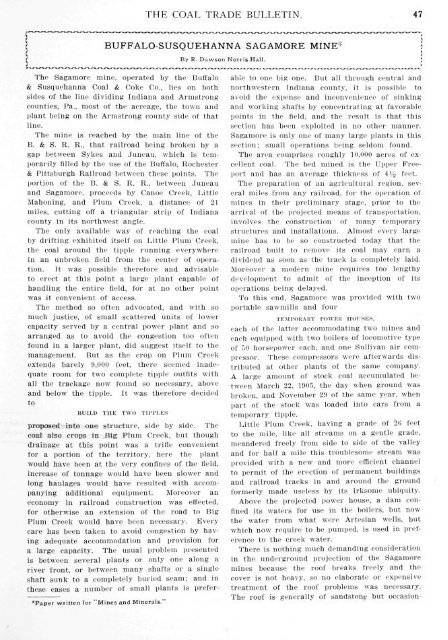u,.:- • - Clpdigital.org
u,.:- • - Clpdigital.org
u,.:- • - Clpdigital.org
Create successful ePaper yourself
Turn your PDF publications into a flip-book with our unique Google optimized e-Paper software.
THE COAL TRADE BULLETIN. 47<br />
BUFFALO-SUSQUEHANNA SAGAMORE MINE 1<br />
By R. Dawson Norris Hal<br />
The Sagamore mine, operated by the Buffalo<br />
& Susquehanna Coal & Coke Co., lies on both<br />
sides of the line dividing Indiana and Armstrong<br />
counties, Pa., most of the acreage, the town and<br />
plant being on the Armstrong county side of that<br />
line.<br />
The mine is reached by the main line of the<br />
B. & S. R. R.. that railroad being broken by a<br />
gap between Sykes and Juneau, which is temporarily<br />
filled by the use of the Buffalo, Rochester<br />
& Pittsburgh Railroad between these points. The<br />
portion of the B. & S. R. R., between Juneau<br />
and Sagamore, proceeds by Canoe Creek, Little<br />
Mahoning, and Plum Creek, a distance of 21<br />
miles, cutting off a triangular strip of Indiana<br />
county in its northwest angle.<br />
The only available way of reaching the coal<br />
by drifting exhibited itself on Little Plum Creek,<br />
the coal around the tipple running everywhere<br />
in an unbroken field from the center of operation,<br />
it was possible therefore and advisable<br />
to erect at this point a large plant capable of<br />
handling the entire field, for at no other point<br />
was it convenient of access.<br />
The method so often advocated, and with so<br />
much justice, of small scattered units of lower<br />
capacity served by a central power plant and so<br />
arranged as to avoid the congestion too often<br />
found in a larger plant, did suggest itself to the<br />
management. But as the crop on Plum Creek<br />
extends barely 9,000 feet, there seemed inadequate<br />
room for two complete tipple outfits with<br />
all the trackage now found so necessary, above<br />
and below the tipple. It was therefore decided<br />
to<br />
BUILD THE TWO TITPI.ES<br />
proposed into one structure, side by side. The<br />
coal also crops in Big Plum Creek, but though<br />
drainage at this point was a trifle convenient<br />
for a portion of the territory, here the plant<br />
would have been at the very confines of the field,<br />
increase of tonnage would have been slower and<br />
long haulages would have resulted with accompanying<br />
additional equipment. Moreover an<br />
economy in railroad construction was effected,<br />
for otherwise an extension of the road to Big<br />
Plum Creek would have been necessary- Every<br />
care has been taken to avoid congestion by having<br />
adequate accommodation and provision for<br />
a large capacity. The usual problem presented<br />
is between several plants or only one along a<br />
river front, or between many shafts or a single<br />
shaft sunk to a completely buried seam; and in<br />
these cases a number of small plants is prefer-<br />
<strong>•</strong>Paper written for "Mines and Minerals."<br />
able to one big one. But all through central and<br />
northwestern Indiana county, it is possible to<br />
avoid the expense and inconvenience of sinking<br />
and working shafts by concentrating at favorable<br />
points in the field, and the result is that this<br />
section has been exploited in no other manner.<br />
Sagamore is only one of many large plants in this<br />
section; small operations being seldom found.<br />
The area comprises roughly 10,000 acres of excellent<br />
coal. The bed mined is the Upper Freeport<br />
and has an average thickness of 4 1 /. feet.<br />
The preparation of an agricultural region, several<br />
miles from any railroad, for the operation of<br />
mines in their preliminary stage, prior to the<br />
arrival of the projected means of transportation,<br />
involves the construction of many temporary<br />
structures and installations. Almost every large<br />
mine has to be so constructed today that the<br />
railroad built to remove its coal may earn a<br />
dividend as soon as the track is completely laid.<br />
Moreover a modern mine requires too lengthy<br />
development to admit of the inception of its<br />
operations being delayed.<br />
To this end. Sagamore was provided with two<br />
portable sawmills and four<br />
TEMPORARY POWER HOUSES,<br />
each of the latter accommodating two mines and<br />
each equipped with two boilers of locomotive type<br />
of 50 horsepower each, and one Sullivan air compressor.<br />
These compressors were afterwards distributed<br />
at other plants of the same company.<br />
A large amount of stock coal accumulated between<br />
March 22, 1905, the day when ground was<br />
broken, and November 29 of the same year, when<br />
part of the stock was loaded into cars from a<br />
temporary tipple.<br />
Little Plum Creek, having a grade of 26 feet<br />
to the mile, like all streams on a gentle grade.<br />
meandered freely from side to side of the valley<br />
and for half a mile this troublesome stream was<br />
provided with a new and more efficient channel<br />
to permit of the erection of permanent buildings<br />
and railroad tracks in and around the ground<br />
formerly made useless by its irksome ubiquity.<br />
Above the projected power house, a dam confined<br />
its waters for use in the boilers, but now<br />
the water from what were Artesian wells, but<br />
which now require to be pumped, is used in preference<br />
to the creek water.<br />
There is nothing much demanding consideration<br />
in the underground projection of the Sagamore<br />
mines because the roof breaks freely and the<br />
cover is not heavy, so no elaborate or expensive<br />
treatment of the roof problems was necessary.<br />
The roof is generally of sandstone but occasion-
















